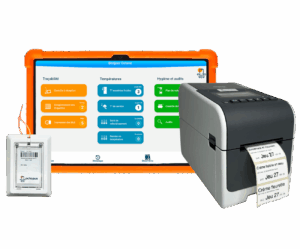Butchery and Delicatessen: What Are the Best Practices?
On Monday, February 14, the major annual event organized by Octopus HACCP and the CFBCT took place, focusing on the theme “Trends and Best Practices 2022.”
The three invited participants held a 30-minute discussion on 2022 trends in butchery and delicatessen:
- Sophie Morel, Quality & Innovation Project Manager, CFBCT
- Thomas Cosse, Artisan Butcher and Delicatessen Owner, Boucheries Cosse
- François-Xavier Renaux, Key Account Manager, Octopus HACCP
Several key topics were addressed, ranging from animal welfare and local sourcing to hygiene practices and 2022 trends such as click and collect.
For Thomas Cosse, animal welfare is essential—both for his customers and his butcher shops. Current regulations and the Climate Law now require environmental labeling. He goes further by explaining to his customers where the meat comes from and how the animals are treated.
Ensuring traceability and being transparent with consumers is crucial: the product’s quality and the origin of beef must be clearly stated (as required by law).
For both Thomas and Sophie, “local” means choosing at least French-origin products. Working with producers they meet in person, directly in their regions, helps build strong relationships. Choosing French products also ensures adherence to strict quality standards. Whenever possible, butchers prefer ultra-short supply chains that allow customers to discover regional products.
In artisanal butchery, official labels are not always present—though some products may be protected by AOC or AOP designations. While the Red Label is shared with mass retail, not all farmers adhere to it. However, that doesn’t mean their products are of poor quality!
How to Share Farmers’ Passion?
Through customer communication and social media, it’s possible to convey the passion behind butchery and delicatessen. Digital tools are available to make professionals’ lives easier. Creating a website, managing a Facebook or Instagram page, and setting up a click-and-collect or pedestrian drive-thru service are all great ways to stand out in 2022.
You can also offer home delivery. Don’t hesitate to install refrigerated self-service lockers so customers can collect their orders during or outside business hours. Some regions even offer financial support for these types of investments.
Digital solutions also help save time in business operations, such as order management, hygiene, and HACCP compliance.
What Are Social Media Used For?
Posting photos or videos of your products or team members helps enhance the visibility and image of your butcher shop. It serves as a digital showcase that highlights the butcher’s craft and the quality of artisanal work.
How to Keep Your Facebook Page Active?
You can film your visits to farmers, showcase your staff and their creativity, passion, and expertise, as well as their interactions with customers. It’s important to respond to comments with patience and positivity.
What About Butcher Training?
What solutions are available to train young people and retain them through apprenticeships and Professional Qualification Certificates (CQP)?
In Paris, institutions like the EPB and the ENSMV offer additional training opportunities—covering hygiene practices, advanced workshops on display arrangement, charcuterie preparation, and more.
The replay



